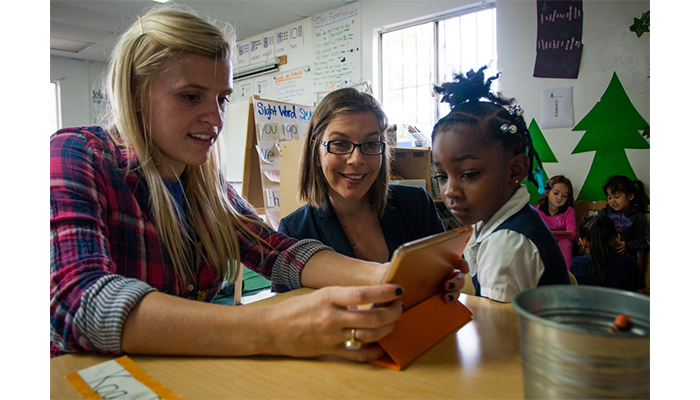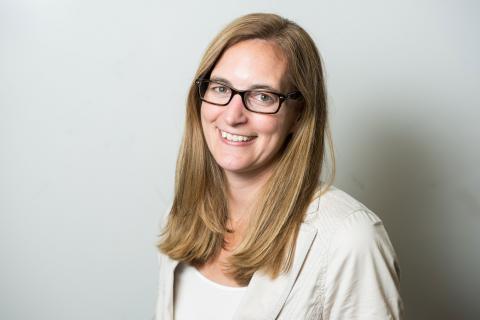Exceptional Ideas and Practical Solutions for Next Gen Learning in K-12 Schools
Topics

We’ve all had the experience of truly purposeful, authentic learning and know how valuable it is. Educators are taking the best of what we know about learning, student support, effective instruction, and interpersonal skill-building to completely reimagine schools so that students experience that kind of purposeful learning all day, every day.
Reimagining how students learn involves tackling a multidimensional challenge head-on. Here's how 13 schools across the country are doing just that.
Reimagining how students learn involves tackling a multidimensional challenge head-on. So when NGLC shifted its K-12 grantmaking away from middle school learning technologies to move toward whole school models that completely transformed learning, we knew we were challenging the field to build on the work of blended learning pioneers. We asked school developers to redesign school by putting together all that we know about how people learn, all that we know about the comprehensive skills and knowledge needed to succeed in college, in careers and in life, and all that we can dream about the future of education.
Recognizing the Need to Totally Rework K-12 Education
We saw the need for dramatic improvements in achievement for students in low-income communities, and believed that incremental changes to today’s schools would not make a big enough dent. Students need more from us, so we began looking for models that completely transformed school as we know it.
NGLC has funded new models for schools since 2012. The most recent cohort that launched their models this past academic year (plus one more ready to open this coming fall) are showing us just how many possibilities there are for reimagining school. These educators are connecting blended learning and self-paced, mastery-based progression with projects, games, entrepreneurship, design thinking, and personalized learning strategies.
Innovative Ideas are Great, but Actionable Plans are Better
Although we challenged the field to put forth exceptional ideas, K-12 education needs practical solutions. These next gen school developers are teaching us how to completely recreate school on the same budget, with the same human resources, and for the same students as we would find in any of the nation’s public schools, even those dealing with the most intractable problems in the most challenging environments.
How can you expand the ability of educators everywhere to dream of a new future for schools? By increasing the number and diversity of examples from which one can draw inspiration and direction. The school models from NGLC grantees now fill the landscape offering even more examples of student-centered, learning-based, technology-enabled schools.
New School Models that Rethink the K-12 Experience
And here they are. We offer up these examples through profiles, two-page snapshots of each school model design, from vision to academic model and even organizational structure, and from per-pupil budget to student demographics and tech tools. Be prepared to be inspired.
- Vertus Charter School. Strong relationships, personalized year-round academics, character education, and career preparation are the four pillars of this high school for boys that expects students to earn a diploma and a technical certificate or job credential.
- Valor Collegiate Academies. A single school model that needs to work for all students across a wide range of backgrounds, academic preparation, and life experience is grounded in adolescent development, and instructional and learning shifts across four stages from grade 5 to grade 12.
- Thrive Public Schools. The greater purpose of learning at this K-8 school is not only to learn to “do,” but also to learn to “be.” Tinkering and project-based learning is coupled with social-emotional learning and multi-age groupings with team teaching.
- Piedmont City School District: Piedmont Middle School. Most NGLC schools are in urban locations, but rural districts serve the majority of students in over half the states. Piedmont is demonstrating that next gen learning, in the form of advanced mastery, relevance, student ownership, and a new approach to organizing time, talent, technology, and partnerships can work in a rural setting, too.
- Montessori for All: Magnolia Montessori. Ever wonder what would happen in a school that was a mash-up of blended learning, a high-performing charter school model, and authentic Montessori schooling?
- InnovateEDU, Inc.: Brooklyn Laboratory Charter Schools. LAB is situated in the midst of a hub of tech innovation, emphasizes entrepreneurial learning, intense tutoring, game-based adaptive courseware, and teacher-led lessons, making learning rigorous and joyful.
- Education for Change: Epic Charter School. Oakland, California’s youth are being defined by narratives they don’t control, so this school’s founders invoked a different narrative, a hero’s journey, to develop innovators and engineers who have the skills and confidence to design creative solutions to real-world challenges.
- Design Tech High School. Curious how the extreme personalization found with companies like Amazon and Netflix could be applied to a school setting? Or how design thinking and the best resources found in Silicon Valley could transform school-based learning?
- Caliber Schools: Caliber: Beta Academy. Writing, engineering/coding/robotics, and an explicit social-emotional curriculum sit alongside blended learning for English and math and project-based learning for science and social studies.
- Building 21: B21 Philadelphia. Picture school as a network with an individual learner at the center who is connected to competency-based learning through integrated courses, technology, deep personal relationships, and powerful experiences.
- Blackstone Valley Prep Mayoral Academy: BVP High. BVP creates daily opportunities for teachers and students to work in ratios of 1:5, 1:3, and even 1:1 for deep personalization to meet the needs of an intentionally diverse student population.
- Battelle Education: Metro Institute of Technology. This school doesn’t open until fall 2015, but that doesn’t deter from the inspiration of a personalized learning model that raises the bar for high school completion to also include a college degree or certificate.
- Alliance College-Ready Public Schools: Baxter High School. The Personalized Alliance College Experience (PACE) model integrates blended learning, early college high school, and competency-based progression.
Just as these educators are building on the work of those who first used blended learning, we want to know: how would you build on the work of these personalized learning pioneers?
What should the coming wave of next gen learning look like?




